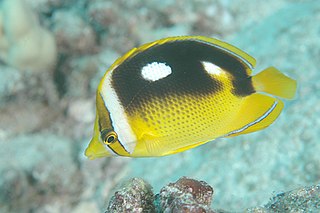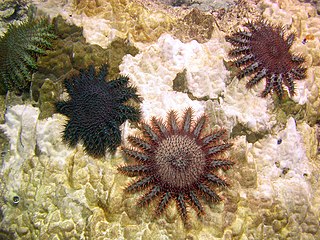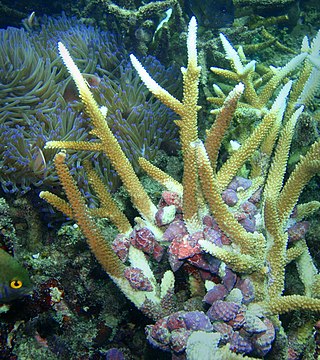
Coral sand is a form of aragonite sand particles originating in tropical and sub-tropical marine environments primarily from bioerosion of limestone skeletal material of marine organisms. Often, this is due to corallivores, such as parrotfish, which excrete sand after digestion. However, the term "coral" in coral sand is used loosely in this sense to mean limestone of recent biological origin; corals are not the dominant contributors of sand particles to most such deposits. Rather, coral sand is a mix of coral and/or remnant skeletal fragments of foraminifera, calcareous algae, molluscs, and crustaceans. Because it is composed of limestone, coral sand is acid-soluble.

Halimeda is a genus of green macroalgae. The algal body (thallus) is composed of calcified green segments. Calcium carbonate is deposited in its tissues, making it inedible to most herbivores. However one species, Halimeda tuna, was described as pleasant to eat with oil, vinegar, and salt.

Crustose is a habit of some types of algae and lichens in which the organism grows tightly appressed to a substrate, forming a biological layer. Crustose adheres very closely to the substrates at all points. Crustose is found on rocks and tree bark. Some species of marine algae of the Rhodophyta, in particular members of the order Corallinales, family Corallinaceae, subfamily Melobesioideae with cell walls containing calcium carbonate grow to great depths in the intertidal zone, forming crusts on various substrates. The substrate can be rocks throughout the intertidal zone, or, as in the case of the Corallinales, reef-building corals, and other living organisms including plants, such as mangroves and animals such as shelled molluscs. The coralline red algae are major members of coral reef communities, cementing the corals together with their crusts. Among the brown algae, the order Ralfsiales comprises two families of crustose algae.

The four-spotted butterflyfish or fourspot butterflyfish is a species of butterflyfish found in the Pacific Ocean from the Ryukyus, Ogasawara (Bonin) Islands and Taiwan to the Hawaiian, Marquesan, and Pitcairn islands, south to the Samoan and Austral Islands and the Marianas and Marshall Islands in Micronesia.
Skeletal eroding band (SEB) is a disease of corals that appears as a black or dark gray band that slowly advances over corals, leaving a spotted region of dead coral in its wake. It is the most common disease of corals in the Indian and Pacific Oceans, and is also found in the Red Sea.

Acanthaster is a bitypic genus of large and venomous starfish placed in its own family, Acanthasteridae. Its two members are known as crown-of-thorns starfish. Acanthaster are native to coral reefs in Indo-Pacific region.
The Arrecifes de Cozumel National Park is off the coast of the island of Cozumel in the state of Quintana Roo, Mexico. The Cozumel reef system is part of the Mesoamerican Barrier Reef System, the second largest coral reef system in the world. Even though almost the entire island of Cozumel is surrounded by coral reefs, the park only encompasses the reefs on the south side of the island. It begins just south of the International Pier and continues down and around Punta Sur and up just a small portion of the east side of the island. The park contains both shallow and mesophotic coral reefs and extends to the 100 m depth isobar.

Drupella cornus, common name : the horn drupe, is a species of sea snail, a marine gastropod mollusk in the family Muricidae, the murex snails or rock snails.

Drupella rugosa, common name : the rugose drupe, is a species of sea snail, a marine gastropod mollusk in the family Muricidae, the murex snails or rock snails.

Millepora platyphylla is a species of fire coral, a type of hydrocoral, in the family Milleporidae. It is also known by the common names blade fire coral and plate fire coral. It forms a calcium carbonate skeleton and has toxic, defensive polyps that sting. It obtains nutrients by consuming plankton and via symbiosis with photosynthetic algae. The species is found from the Red Sea and East Africa to northern Australia and French Polynesia. It plays an important role in reef-building in the Indo-Pacific region. Depending on its environment, it can have a variety of different forms and structures.

Porites nodifera, also known as dome coral, is a species of stony coral in the Poritidae family.

Euphyllia cristata is commonly called grape coral. E. cristata is a kind of stony or hard coral in the family Euphylliidae; it also belongs to the genus Euphyllia in the order of Scleractinia. E. cristata has a wide range of distribution throughout the tropical waters of the Indo-West Pacific area with a large presence in Indonesia. However, despite this large range of distribution, E. cristata has a slightly lower abundance compared to other species, making them a little more uncommon to find. They are typically found in shallow waters from 1–35 meters deep.

A Mesophotic coral reef or mesophotic coral ecosystem (MCE), originally from the Latin word meso (meaning middle) and photic (meaning light), is characterised by the presence of both light-dependent coral and algae, and organisms that can be found in water with low light penetration. Mesophotic Coral Ecosystem (MCEs) is a new, widely-adopted term used to refer to mesophotic coral reefs, as opposed to other similar terms like "deep coral reef communities" and "twilight zone", since those terms sometimes are confused due to their unclear, interchangeable nature.

A corallivore is an animal that feeds on coral. Corallivores are an important group of reef organism because they can influence coral abundance, distribution, and community structure. Corallivores feed on coral using a variety of unique adaptations and strategies. Known corallivores include certain mollusks, annelids, fish, crustaceans, flatworms and echinoderms. The first recorded evidence of corallivory was presented by Charles Darwin in 1842 during his voyage on HMS Beagle in which he found coral in the stomach of two Scarus parrotfish.

Katrin Juliane Meissner is a physical oceanographer and climate scientist known for climate models assessing the impact of abrupt climate change on terrestrial and marine biogeochemical cycling.

Scarus fuscopurpureus, common name purple-brown parrotfish, is a species of marine ray-finned fish, belonging to the class Actinopterygii. It is a parrotfish in the family Scaridae. It occurs in the western Indian Ocean, the Red Sea, the gulf of Aden and the Persain Gulf. Countries in which boarder these waters include, but are not limited to Egypt, Sudan, Saudi Arabia, Yemen, Kuwait, and the United Arab Emirates.
Colette Marie St. Mary is a professor and associate chair of the biology department at the University of Florida. Her research focuses include behavioral and evolutionary ecology, speciation, sexual selection, and evolutionary aspects of cancer. Working mainly with fish model organisms, St. Mary is also interested in marine fisheries management and reproduction and evolution in hatchery settings. St. Mary received her Bachelor's degree in Biology from Harvard Radcliffe College before earning her Ph.D from University of California, Santa Barbara in 1994. She is the first African-American woman to ever receive a Ph.D. in evolutionary biology in the United States. Her thesis was on the determinant of sex allocation patterns and maintenance of simultaneous hermaphroditism in the blue banded goby and zebra goby.

Halichoeres burekae, the Mardi Gras wrasse, is a species of wrasse native to the Gulf of Mexico. The species was first described from the Flower Garden Banks National Marine Sanctuary, in the northwestern Gulf of Mexico, but has since been recorded in other areas of the southern Gulf of Mexico. Because it is a small species that feeds on plankton in the water column, it is likely a preferred prey for invasive Lionfish. It also has a very restricted range, and corresponding relatively small population, what resulted in this species being listed as Endangered in the IUCN Red List.

Ceraesignum maximum is a species of gastropods belonging to the family Vermetidae.

Oculina arbuscula is a branching temperate coral found along the east coast of the United States from Florida to North Carolina. It has a facultative symbiosis with microalgae of the family Symbiodiniaceae. Unlike tropical corals, O. arbuscula can survive without its algal endosymbionts by switching to a predominantly heterotrophic feeding strategy. Symbiotic colonies are typically found in shallower waters due to light availability, whereas aposymbiotic or mixed colonies are found as deep as 200m. The ability of O. arbuscula to exist in different symbiotic states makes it a good model system for studying the cnidarian-dinoflagellate symbiosis.
















